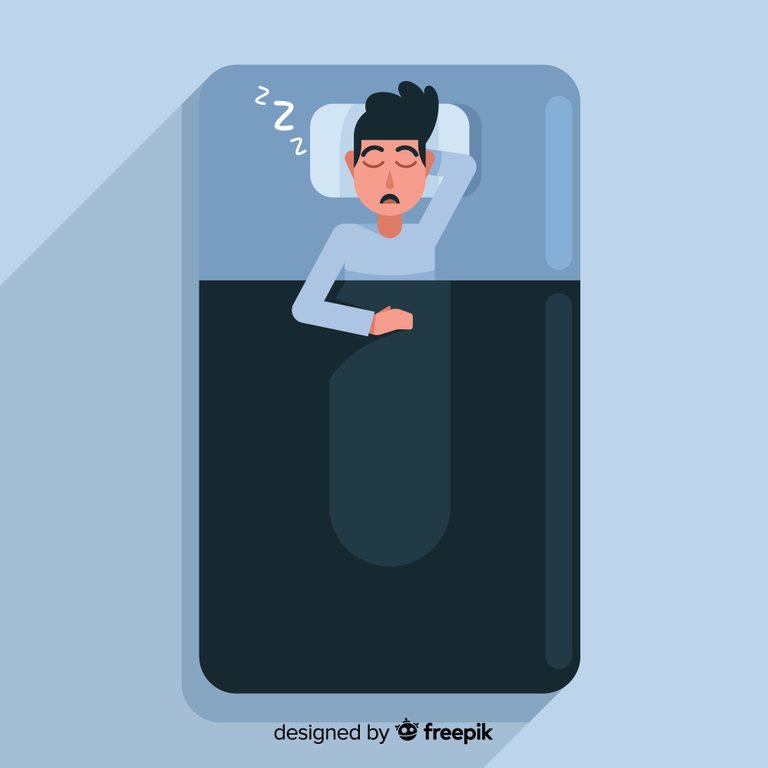Feeling So Weak In The Morning? This Could Be The Reason!
Introduction
Hello Stemsocial family! I'm back again after a very long break due to being busy doing research (Just finished three papers with my colleagues, and I am waiting for them to be published) and studying. As you are used to me, I always love to make posts in the medical field, as that's what I'm actually studying at university, and so this time I'm bringing you an interesting topic, which is Sleep Apnea.
Overview

Image by Freepik
Sleep apnea is a prevalent sleep disorder that affects millions of people worldwide. It is characterized by interruptions in breathing during sleep, leading to repeated awakenings and disturbances in the normal sleep cycle. These pauses in breathing can last for several seconds (usually more than 10 seconds) and typically occur numerous times throughout the night. The two primary types of sleep apnea are obstructive sleep apnea (OSA) and central sleep apnea (CSA), with the first one being the most common form.
Definition:
Sleep apnea is a sleep disorder in which an individual experiences recurrent interruptions in breathing during sleep. These interruptions, known as apneas, can result in reduced oxygen levels in the blood and disrupted sleep patterns.
Some terminology: Apnea = cessation of breathing. So, sleep apnea = the cessation of breathing during sleep.
Symptoms:

Image by Freepik
Common symptoms of sleep apnea include:
- Loud and chronic snoring
- Gasping or choking sensations during sleep
- Excessive daytime sleepiness or fatigue
- Morning headaches
- Difficulty concentrating or memory problems
- Irritability and mood changes
- Frequent nighttime awakenings (Unrestful sleep)
Regarding the last point, the patient wakes up during the night due to shortness of breath, yet it's not enough to regain consciousness.
Types of Sleep Apnea:
Obstructive Sleep Apnea (OSA):
OSA is the most prevalent form of sleep apnea, accounting for approximately 85% of cases. It occurs when the muscles at the back of the throat relax excessively, leading to the obstruction of the airway. The soft tissue collapses and narrows the airway, causing breathing pauses until the brain detects the lack of oxygen and briefly wakes the individual to reopen the airway. These awakenings are usually brief and may not be fully remembered, but they disrupt the sleep cycle and lead to fragmented sleep.
Central Sleep Apnea (CSA):
CSA is less common and differs from OSA in its root cause. In CSA, the brain fails to transmit the proper signals to the muscles responsible for controlling breathing, resulting in temporary pauses in respiration. Unlike OSA, there is no physical blockage of the airway. CSA can be associated with certain medical conditions, such as heart failure, brainstem lesions, or neurological disorders.
Diagnosis:
If sleep apnea is suspected, a medical evaluation is necessary to confirm the diagnosis. A sleep study, known as polysomnography, is the standard diagnostic test. It is usually conducted in a sleep clinic or home setting and involves monitoring various physiological parameters during sleep, such as brain activity, eye movements, muscle activity, heart rate, respiratory effort, airflow, and blood oxygen levels. The sleep study provides essential data to diagnose and differentiate between OSA and CSA.
And finally treatment:
Continuous Positive Airway Pressure (CPAP):
CPAP is one of the most effective treatments for obstructive sleep apnea. It involves wearing a mask over the nose or mouth during sleep, connected to a machine that delivers a continuous flow of air pressure. This air pressure keeps the airway open, preventing apneas and snoring. (Gotta say, it looks so uncomfortable)Bi-level Positive Airway Pressure (BiPAP):
BiPAP is similar to CPAP but delivers two levels of pressure: a higher level during inhalation and a lower level during exhalation. It may be used for individuals who find CPAP uncomfortable or have difficulty exhaling against the continuous pressure.Adaptive Servo-Ventilation (ASV):
ASV is a newer treatment option that continuously adjusts the air pressure based on an individual's breathing patterns. It is often used to treat central sleep apnea and complex sleep apnea syndrome (a combination of OSA and CSA).Lifestyle Changes:
In some cases, lifestyle modifications like weight loss, avoiding alcohol and sedatives before bedtime, and adopting a regular sleep schedule may help improve sleep apnea symptoms, especially if the condition is mild.In severe disease, upper airway surgery is considered.
In conclusion, sleep apnea is a serious sleep disorder characterized by breathing interruptions during sleep. Prompt diagnosis and appropriate treatment are crucial to managing the condition effectively and improving overall sleep quality and daytime functioning. If you suspect you or someone you know may have sleep apnea, seeking medical evaluation and professional guidance is essential for optimal health and well-being.
Thanks for reading! Stay safe. 🤗
References:
NO.1
NO.2
NO.3
NO4. I also used Boards & Beyond slides and video (Pulmonary).
Congratulations!
Your post has been manually curated and reblogged.
You can follow our curation trail on Hive.Vote
If you want to support us and the authors we vote for you can upvote this comment or delegate some Hive Power to our account. Thanks!
Propose a worthy post by mentioning us in the post or in a comment.
We reblog curated posts, follow us if you wish to see them in your feed.
Thanks for your contribution to the STEMsocial community. Feel free to join us on discord to get to know the rest of us!
Please consider delegating to the @stemsocial account (85% of the curation rewards are returned).
Thanks for including @stemsocial as a beneficiary, which gives you stronger support.